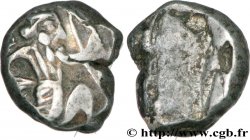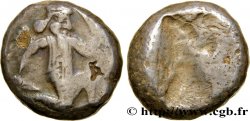v43_0248 - PERSIA - REGNO ACHEMENIDO - ARTAXERXES II MNEMON Quart de sicle d'argent
MONNAIES 43 (2010)
起拍价 : 250.00 €
估价 : 350.00 €
未售出的物品
起拍价 : 250.00 €
估价 : 350.00 €
未售出的物品
种类 Quart de sicle d'argent
日期: c. 400-350 AC.
铸币厂名称/城市 Sardes
材质 silver
直径 8,5 mm
重量 1,24 g.
稀少度 R2
关于品相的说明
Exemplaire frappé sur un petit flan globulaire. Très joli droit, bien centré, pratiquement complet. Revers énigmatique. Recouvert d’une épaisse patine gris foncé
出版目录中的项代码 :
正面
正面的文字 ANÉPIGRAPHE.
正面的说明书 Le Grand Roi barbu, en archer mélophore, à demi-agenouillé à droite, coiffé de la cidaris, surmontée de cinq dents, vêtu de la candys tirant à l’arc ; le carquois rempli de flèches suspendu à son épaule est bien visible ; ligne de sol.
背面
背面的说明书 Carré creux allongé, présentant des aspérités irrégulières en forme de chien courant.
评论
Ce type bien particulier donné comme un quart de sicle (poids théorique 1,32 g) était attribué par Babelon à Artaxerxès II Mnémon (405-359 avant J.-C.) tandis que David Sear et les auteurs du British Museum l’attribuent à Darius Ier (510-486 avant J.-C.) penchent pour un tiers de sicle (poids théorique 1,76 g). L’exemplaire reproduit dans le catalogue d’Ernest Babelon pèse 1,78 g. Dans son traité, le même Ernest Babelon (p. 61-62, n° 28) attribue une diobole (1,20 g) trouée, conservée à Paris à Artaxerxès III Ochus (359-338 avant J.-C.). Ce type de monnaie divisionnaire est en fait très rare.








 对产品描述纠错
对产品描述纠错 打印
打印 分享我的选择
分享我的选择 提问
提问 Consign / sell
Consign / sell
 产品介绍
产品介绍
